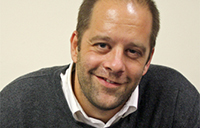On Sept. 15, York’s Canadian Writers in Person course and lecture series presented author Tamas Dobozy reading from his novel Siege 13. Special correspondent Chris Cornish (BA Hons. ’04, MA ’09) sent the following report to YFile.
“Tíbor Kálmán. Tíbor Kálmán’s villa.” That’s what Györgyi told Zoltán the night they went AWOL from the camp, the two of them huddled in the barracks amidst the other conscripts, boys like them, but asleep, some as young as sixteen, called on in the last hours of the war in a futile effort to salvage a regime already fallen, a country and people already defeated. “We need to get to Mátyásföld,” Györgyi said, “that’s where the villa is. Tíbor Kálmán will give us papers.”
from Siege 13
by Tamas Dobozy

In the research for his collection of interlinked short stories about the siege of Budapest during the Second World War, author Tamas Dobozy struggled with the following questions: How do you get information about the war from people who are damaged and still suffering from the effects of trauma several years later? How also is trauma passed on, inherited by subsequent generations who didn’t experience it directly? With these questions in mind, Dobozy’s stories about the siege traverse different time periods and geographies, tracing the effects of the war on the lives, families and communities of 1940s Hungary but also modern-day Toronto and New York. Dobozy shared his insights on the siege and the creative process at his appearance at the Canadian Writers in Person reading series on Sept. 15.
Also a professor at Wilfrid Laurier University in Waterloo, Ont., Dobozy gave a brief background lecture on four key events of Hungarian history that informed his stories. By connecting the Treaty of Trianon, which redrew Hungary’s borders after the First World War, the siege of Budapest during the Second World War, the unsuccessful revolution against the Soviets in 1956 and the fall of communism in 1989, Dobozy showed how the history of Hungary is not a simple matter of past events. Rather, it is a complex and ongoing story that is very much a part of the present as it is rooted in the past. “History is happening and it’s continuing now. The idea of the New World is that you can step out of the past as if there’s no influence. Only a crazy person would think that way.”
Dobozy shared some of the photographs of Budapest from the Second World War that inspired some of his work, often showing people and normal life carrying on despite the chaos of war. He was interested in how civilians were pressed into service, as if they just “got off work from their job at the bank to take their position at a machine gun.” Dobozy did a significant amount of research, speaks Hungarian and lived there for a period of time, but he was careful not to bog the story down with too much historical detail. Rather, he was more interested in capturing the “tenor of the history, the politics, the sensed reality.” Initially concerned that he may have occasionally stretched the fiction too far, he was surprised when readers shared true stories that were wilder than anything he wrote, such as a woman who gave birth in the streets.
Dobozy noted that there are generally two approaches to this kind of history: those who “chew and obsess over the past” and those who let it go. There was also a tendency among many who lived through it, such as his father and grandmother, to stay silent and to resist reliving those times. His stories are entirely fictional, despite their basis in historical fact, yet many readers claimed that they spoke to them in ways their family wouldn’t. Dobozy claimed that he simply had to write through it to understand what happened and break the silence. True to a fiction writer, “If you don’t tell me your past, I’ll imagine it.”
The Canadian Writers in Person series of public readings at York, which are free and open to the public, are also part of an introductory course on Canadian literature. It is sponsored in part by the Canada Council for the Arts. For a full schedule of upcoming writers this year, see the Sept. 15 issue of YFile for a full schedule of upcoming writers.


